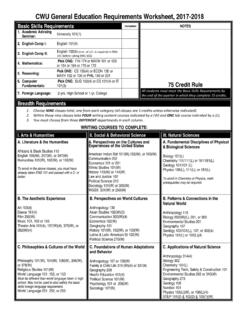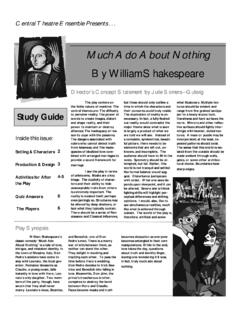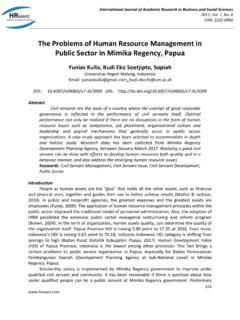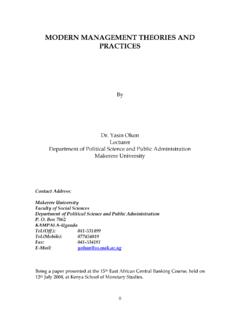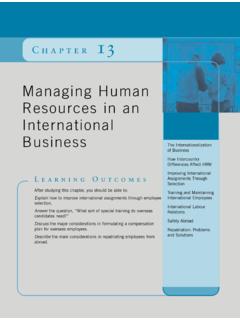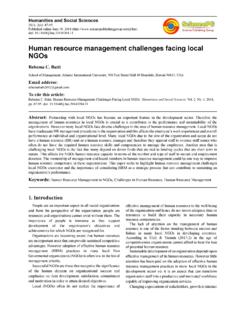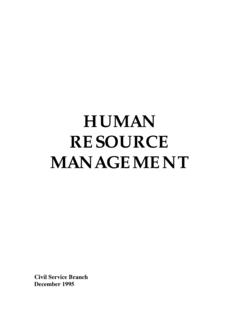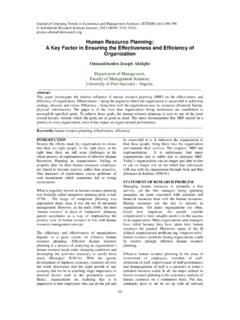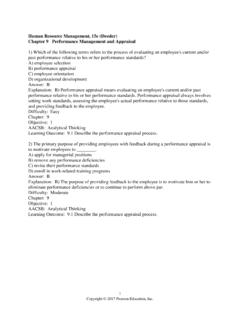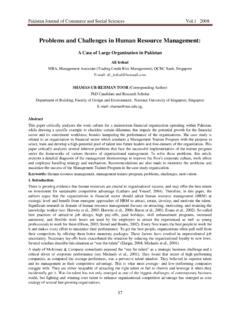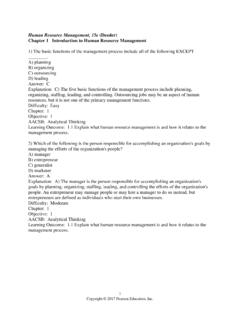Transcription of Syllabus Sample - Central Washington University
1 COURSE Syllabus PROBLEMS IN human resource management SPRING QUARTER, 2013 Section .001 Course Number: HRM Location: TBD Instructor: James B. Avey, Time: 10:00-12:10 M,W Office: Shaw/Smyser,332 Phone: 963-3381 Office Hours: 8:30-10:00AM M, W E- mail: And by Appointment Web page: Texts: Nkomo, , Fottler, ; and McAfee, Applications in human resource management , Cincinnati, OH: South-Western College Publishing, 7th edition, 2011 Course Description: Catalog Description: Analysis and research on selected topics involving contemporary issues in personnel management . This is the capstone course for the HRM specialization. The prerequisites for the course are HRM 381 plus 2 HRM electives. Problems in human resource management takes the foundation established in HRM 381, plus the other human resource electives and provides a forum for students to apply what they have learned.
2 Through the use of the case method presentations, and small group discussions, students will encounter a host of opportunities to try out ideas, behaviors, and yes, even theories. Problems (as the course is called) relies heavily upon in-class involvement, oral presentation, and interaction between and among both students and the instructor. Expect the atmosphere of the class to be positive yet rigorous and dynamic. Extensive library and internet research are required. Statement of Purpose: The course is intended to partially bridge the gap between theory and practice in HRM. By the time students take Problems they will already have completed several HR electives and have been exposed to state of the art HR thought and practices. This course allows students to put their knowledge to work by asking them to solve realistic HR issues and problems. Course Objectives: Upon completion of the course it is expected that students will be able to: Conduct both Internet and secondary library research Effectively work together in small group structures Make meaningful presentations to groups of knowledgeable HR people Sample SyllabusPresent effective and even passionate arguments on HR Topics Identify weaknesses in other people s arguments and presented facts Understand and utilize all completed HR course work to guide strategic HR decisions and behaviors COURSE REQUIREMENTS Class Participation/Attendance/Preparation: Students are urged to ask questions, express opinions, reveal facts, and challenge presented materials.
3 These types of participation are of vital importance to the learning process. In addition, it is expected that all students will be thoroughly prepared for each class discussion. Therefore, the quality of voluntary participation will be considered when assigning final grades. ALL unexcused absences will serve to lower the student s final grade. Any student absent for any of their presentations may expect to receive a 0 for their grade. Major Individual Topical Presentation and Paper: Each individual will select a major topic from those topics presented below. Next, each student will prepare both a formal written term paper to be presented to the instructor as well as an oral presentation to the class. Note that the written paper is due at the start of the class on the assigned presentation day. Be sure to type, double space, carefully proofread, use proper form as discussed in the APA Style Manual, and provide an accurate APA reference section.
4 Sources consulted are to be at least 50% scholarly journals (see attached list). Neither Wikipedia nor textbooks of any kind are acceptable sources. Expected length is 5-6 pages (please do not exceed 6 pages exclusive of references). On the day of your presentation be sure to provide each class member with a detailed outline and a complete list of your references (back-to-back is fine). HRM 486 Possible Term Paper Topics Absenteeism: Cases, Remedies, and Prevention Alcoholism, Drug Addiction, and Work Americans with Disabilities Act: Current Status and Rulings Application Blanks: Creation, Usage, and Legal Obligations Arbitration Costs and Benefits in Settling Labor Relations Disputes Behaviorally-Anchored Rating Scales Behavior Modification Approaches Contingent Workers/Workforce Costing Behaviors Current Immigration Problems Sample SyllabusDiscipline and Disciplinary Action Downsizing the Workplace: Problems and Solutions Drug Testing Issues Early Retirement Plans and Methods Employee Assistance Plans Employee Development Methods Employee Free Choice Act: Plus and Minus Employee Handbooks.
5 What You Need to Know Executive Recruiting and Selection Exit Interviews Flex Time Flexible Benefit Systems Gainsharing Genetic Testing Grievance and Complaint Settlement Methods Health Care Cost Containment Methods HR management for the 21st Century HR Metrics human resource Accounting human resource Information Systems International human resource management in [Named Country] Interviewing Methods in the Selection Process Is Affirmative Action Still Needed in 2012 and Beyond? Job Enrichment Job Sharing Legal Aspects of Pregnancy and Family Leave Policies in WA management Development: Planning & Evaluation Obama Health Care 2012: Good or Bad & Why Outsourcing the human resource Function Paid Family Medical Leave Peer Method of Performance Appraisal Personality Tests and the Selection of Employees Reducing Job Fatigue, Boredom, and Monotony Privacy Concerns of Employees Unions: Current and Future Status Profit Sharing Plans Proper and Improper Termination in Today s Economy Reverse Discrimination and Affirmative Action Today Self-Directed Work Teams Sexual Harassment: Prevention and Corrective Actions Status of Employer Liability and Current Trends in Reference Checking Strategic HR Stress and Burnout: HR Solutions Strikes: management Strategies The Use of the Polygraph (lie detector) in the Selection Process Turnover: How much, How Little?
6 Sample SyllabusWage Compression: Problems and Solutions Women and the Glass Ceiling Workplace violence Why Minimum Wage Harms Our Economy Cases: All class members are responsible to have read each case in preparation for class. The class will be divided into small teams. Each team will have opportunities to lead the case discussions. The case format disbursed in class is the format that must be followed for both written and oral presentation. The team presenting the case will provide the instructor and each class member with a copy of their written analysis at the start of class Also included in this class handout should be any relevant cases, laws or material helpful to the class for case analysis. All class members not presenting are expected to do relevant library/internet research to supplement/explain/refute each case and then come to class prepared to discuss the case.
7 Case grades are based in part on the quality of the presentation and formal write-up, accuracy, currency, adherence to the case method, both succinctness and completeness (covering all important issues), and quality of supplemental materials used. Bullet point write-ups are never acceptable. Rather, a formal and complete written case analysis is expected. Early in the quarter there will be more time for presentation and discussion. However, as the topical presentations begin less time will be available for presentation and discussion of cases. It is up to the instructor to monitor time and inform the class accordingly. Remember, class members other than presenters must have read the presented case and offer substantial rebuttal or alternative ideas to the presenting group in a positive and constructive fashion. All class members are expected to participate DAILY. This is the principle way participation points will be earned.
8 Strategic HRM Simulation Students will be assigned teams for a head to head competition against the other teams in the class in a Strategic HRM Simulation. In this simulation you must incorporate your training from other courses to make strategic HR decisions at least WEEKLY for a firm including compensation and payroll, promotions, training, incentives, hiring, firing, lay-offs and employee relations issues. Based on the team s decisions, the simulation software will calculate the most probably outcome ( , if another team in the course offers higher wages, your turnover may increase). These outcomes will create scores on your balanced scorecard . The PRIMARY way students earn points in this simulation is 1) by winning and 2) peer evaluation. At the end of the simulation the three teams with the highest balanced scorecard average across all time points will receive full credit (200 points pending peer evaluation).
9 All other teams will receive no greater than a C on this Sample Syllabusportion of the course if no other action is taken beyond the simulation performance. HOWEVER, all other teams WILL have an opportunity to earn between 100-200 points on this assignment by writing a 8-10 page paper describing 1) what strategy they used, 2) what actions they took, 3) why those actions did not work and 4) what they would do different now. This written assignment will be graded based on rigorous analysis, appropriate conclusions, logic and flow of the paper. Please note that technical support is available for the simulation for technical (not strategic) questions. Grading: Possible Points Cases: Term Oral and Written Presentation 200 Participation: Including responses to cases/topics 100 Project: Written 100 Oral 100 Strategic HRM Simulation 200 Any team member absent from the presenting group will receive a zero for the case.
10 All written assignments are due at the beginning of the period on the assigned day. No late or make-up assignments will accepted or allowed. Be sure each team member makes an equal contribution to each case presentation. Plagiarism of any kind will result in a failing grade in the class. Final Grades: Final grades will be based on the following percentages: A = 93% C+ = 74% D- = 60% A- = 89% C = 70% B+ = 85% C- = 68% B = 80% D+ = 65% B- = 77% D = 63% If you have any questions regarding your grade or class standing, please talk to the instructor at your convenience. College of Business Honor Code All students are expected to adhere to the CB Honor Code: As College of Business students we pledge to uphold these standards of professionalism and conduct ourselves in accordance with them. We will not lie, cheat, or steal, and will not tolerate those who do.



